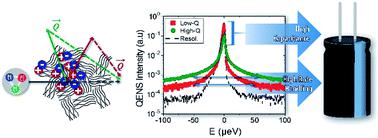当前位置:
X-MOL 学术
›
Sustain. Energy Fuels
›
论文详情
Our official English website, www.x-mol.net, welcomes your feedback! (Note: you will need to create a separate account there.)
Microscopic dynamics in room-temperature ionic liquids confined in materials for supercapacitor applications
Sustainable Energy & Fuels ( IF 5.6 ) Pub Date : 2020-01-15 , DOI: 10.1039/c9se00829b Naresh C. Osti 1, 2, 3, 4 , Eugene Mamontov 1, 2, 3, 4
Sustainable Energy & Fuels ( IF 5.6 ) Pub Date : 2020-01-15 , DOI: 10.1039/c9se00829b Naresh C. Osti 1, 2, 3, 4 , Eugene Mamontov 1, 2, 3, 4
Affiliation

|
The performance of electrical double layer capacitors (EDLCs), also known as supercapacitors, which are composed of porous electrodes and ionic liquid electrolytes, depends largely on the structure and dynamics of molecules/ions at the electrode–electrolyte interfaces. Immobilization of ions on the electrode surface and diffusivity of ions in the middle of the pores are two important phenomena influencing the performance of supercapacitors. In recent years, porous carbon or metal carbide derived electrodes and ionic liquid electrolytes, either in the neat state or mixed with organic solvents, were used to improve the energy and power density of supercapacitors. The molecular/ionic level predictive understanding of ion immobilization and movement inside the pores can be achieved, in principle, using molecular dynamics (MD) simulations. This calls for experimental techniques capable of validating MD predictions and providing directions for future MD studies. Neutron scattering techniques, particularly quasi-elastic neutron scattering (QENS), uniquely provide information directly comparable with MD simulation results. This includes electrolytes confined in electrode materials, due to high penetrative power of neutrons and their high sensitivity to hydrogen-bearing species. This paper reviews recent research where QENS, together with electrochemical measurements and molecular dynamics simulations, has been employed to explore complex electrode/electrolyte systems, which is critical for developing predictive understanding of the charge storage mechanism in supercapacitors.
中文翻译:

限于超级电容器应用的材料中所含室温离子液体的微观动力学
双电层电容器(EDLC)的性能也称为超级电容器,它由多孔电极和离子液体电解质组成,在很大程度上取决于电极-电解质界面上分子/离子的结构和动力学。离子在电极表面的固定和离子在孔中间的扩散是影响超级电容器性能的两个重要现象。近年来,使用多孔碳或金属碳化物衍生的电极和离子液体电解质,无论是纯净状态还是与有机溶剂混合,都可以用来改善超级电容器的能量和功率密度。原则上,可以使用分子动力学(MD)模拟获得对离子在孔内固定和移动的分子/离子水平预测性理解。这就需要能够验证MD预测并为未来MD研究提供指导的实验技术。中子散射技术,特别是准弹性中子散射(QENS),独特地提供了与MD模拟结果直接可比的信息。这包括由于中子的高穿透力及其对含氢物质的高敏感性而限制在电极材料中的电解质。本文回顾了最近的研究,其中QENS与电化学测量和分子动力学模拟一起被用于探索复杂的电极/电解质系统,这对于发展对超级电容器中电荷存储机制的预测性理解至关重要。中子散射技术,特别是准弹性中子散射(QENS),独特地提供了与MD模拟结果直接可比的信息。这包括由于中子的高穿透力以及对含氢物质的高度敏感性而限制在电极材料中的电解质。本文回顾了最近的研究,其中QENS与电化学测量和分子动力学模拟一起被用于探索复杂的电极/电解质系统,这对于发展对超级电容器中电荷存储机制的预测性理解至关重要。中子散射技术,特别是准弹性中子散射(QENS),独特地提供了与MD模拟结果直接可比的信息。这包括由于中子的高穿透力及其对含氢物质的高度敏感性而限制在电极材料中的电解质。本文回顾了最近的研究,其中QENS与电化学测量和分子动力学模拟一起被用于探索复杂的电极/电解质系统,这对于发展对超级电容器中电荷存储机制的预测性理解至关重要。由于中子具有很高的穿透力以及对含氢物质的高度敏感性。本文回顾了最近的研究,其中QENS与电化学测量和分子动力学模拟一起已被用于探索复杂的电极/电解质系统,这对于发展对超级电容器中电荷存储机制的预测性理解至关重要。由于中子具有很高的穿透力以及对含氢物质的高度敏感性。本文回顾了最近的研究,其中QENS与电化学测量和分子动力学模拟一起已被用于探索复杂的电极/电解质系统,这对于发展对超级电容器中电荷存储机制的预测性理解至关重要。
更新日期:2020-01-15
中文翻译:

限于超级电容器应用的材料中所含室温离子液体的微观动力学
双电层电容器(EDLC)的性能也称为超级电容器,它由多孔电极和离子液体电解质组成,在很大程度上取决于电极-电解质界面上分子/离子的结构和动力学。离子在电极表面的固定和离子在孔中间的扩散是影响超级电容器性能的两个重要现象。近年来,使用多孔碳或金属碳化物衍生的电极和离子液体电解质,无论是纯净状态还是与有机溶剂混合,都可以用来改善超级电容器的能量和功率密度。原则上,可以使用分子动力学(MD)模拟获得对离子在孔内固定和移动的分子/离子水平预测性理解。这就需要能够验证MD预测并为未来MD研究提供指导的实验技术。中子散射技术,特别是准弹性中子散射(QENS),独特地提供了与MD模拟结果直接可比的信息。这包括由于中子的高穿透力及其对含氢物质的高敏感性而限制在电极材料中的电解质。本文回顾了最近的研究,其中QENS与电化学测量和分子动力学模拟一起被用于探索复杂的电极/电解质系统,这对于发展对超级电容器中电荷存储机制的预测性理解至关重要。中子散射技术,特别是准弹性中子散射(QENS),独特地提供了与MD模拟结果直接可比的信息。这包括由于中子的高穿透力以及对含氢物质的高度敏感性而限制在电极材料中的电解质。本文回顾了最近的研究,其中QENS与电化学测量和分子动力学模拟一起被用于探索复杂的电极/电解质系统,这对于发展对超级电容器中电荷存储机制的预测性理解至关重要。中子散射技术,特别是准弹性中子散射(QENS),独特地提供了与MD模拟结果直接可比的信息。这包括由于中子的高穿透力及其对含氢物质的高度敏感性而限制在电极材料中的电解质。本文回顾了最近的研究,其中QENS与电化学测量和分子动力学模拟一起被用于探索复杂的电极/电解质系统,这对于发展对超级电容器中电荷存储机制的预测性理解至关重要。由于中子具有很高的穿透力以及对含氢物质的高度敏感性。本文回顾了最近的研究,其中QENS与电化学测量和分子动力学模拟一起已被用于探索复杂的电极/电解质系统,这对于发展对超级电容器中电荷存储机制的预测性理解至关重要。由于中子具有很高的穿透力以及对含氢物质的高度敏感性。本文回顾了最近的研究,其中QENS与电化学测量和分子动力学模拟一起已被用于探索复杂的电极/电解质系统,这对于发展对超级电容器中电荷存储机制的预测性理解至关重要。


























 京公网安备 11010802027423号
京公网安备 11010802027423号